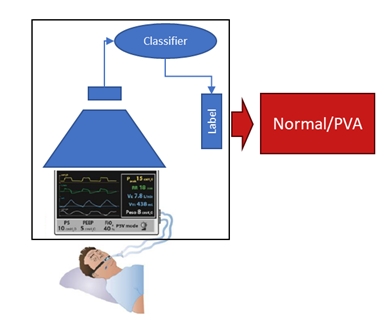Project: Visual Analytics for Unsupervised Learning for Patient-Ventilator Asynchrony (PVA) detection
Description

Background:
Mechanical ventilation (MV) is a life-saving intervention used to support patients with respiratory failure. However, the effectiveness of MV can be compromised due to patient-ventilator asynchrony (PVA), which occurs when the patient's breathing pattern does not align with the ventilator's settings. PVA can lead to patient discomfort, prolonged ventilation, and even lung injury. Recently, we have developed a deep learning model based on a 1D U-Net architecture to filter the pressure, flow, and volume waveforms from the mechanical ventilator and output the timings of patient inspiratory and expiratory efforts. Comparing these timings with the ones from the ventilator, PVAs can be detected and classified.
Project Objectives:
To better understand the model prediction and possibly improve the model performance, in this project, we investigate the network decision process, with particular emphasis on which part of the waveforms contribute the most to the decision for different types of PVAs.
Visual
analytics (VA) methods are an interesting potential solution for explainable
AI[1,2]. You will develop a VA system tailored towards the specific
understanding of the inner workings of PVA models, and provide actionable insights
to improve the model performance.
Requirements
- Good programming skills
- Understanding of signal analysis
- Understanding of ML models and their inner workings, ideally also explainable methods
- Visualization background
[1] Meng, Linhao, Stef Van Den Elzen, and Anna Vilanova. "ModelWise: Interactive Model Comparison for Model Diagnosis, Improvement and Selection." Computer Graphics Forum. Vol. 41. No. 3. 2022.
[2] N. Pezzotti, T. Höllt, J. Van Gemert, B. P. F. Lelieveldt, E. Eisemann and A. Vilanova, "DeepEyes: Progressive Visual Analytics for Designing Deep Neural Networks," in IEEE Transactions on Visualization and Computer Graphics, vol. 24, no. 1, pp. 98-108, Jan. 2018.
Details
- Supervisor
-
 Anna Vilanova
Anna Vilanova
- Secondary supervisor
-
STSimona Turco (BM/d EE)
- Interested?
- Get in contact